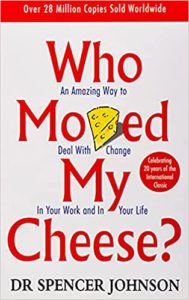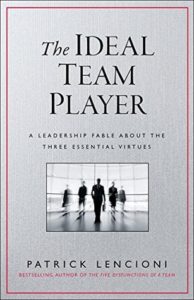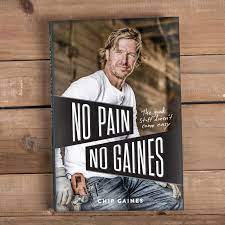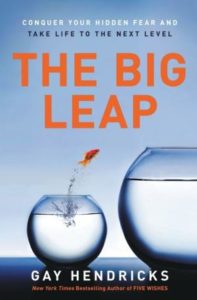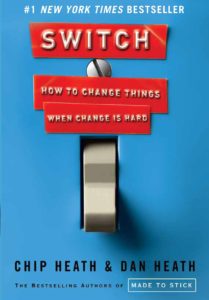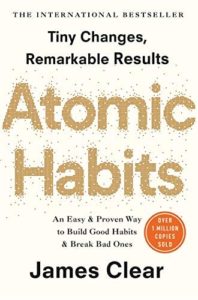
The Leap Team loves a good book or two or ten. If you peeked at our book purchases, you’ll see the diversity of our interests. We figured our newsletter readers would like to see what we have been reading and using in our work with our clients. Enjoy this year’s Team Leap Book Club selections! Reading a book is a good thing to do and with the ability to read, listen and sometimes even watch a book or story on stage or on a screen, it is time to make your next selection. Here are some of ours…
Books reviewed in this issue of our newsletter:
- The Imperfect Board Member
- The Heart Led Leader
- Personal and Executive Coaching-The Complete Guide for Mental Health Professionals
- Blink: The Power of Thinking Without Thinking
- The 7 Habits of Highly Effective People: Powerful Lessons in Personal Change
- No Ego
- The AAA Way to Fundraising Success
By Jim Brown
Publisher: Jossey-Bass
ISBN-10: 0787986100
By Chuck McPherson ~ This book provided a rather quick and easy read while providing some key insights for Board Members. CEO’s, Executive Directors and Management could also have valuable takeaways. Through his story telling, Jim Brown outlined clear roles and responsibilities using the terminology of a straight line meaning that each has clear reporting relationships and “end arounds” need to be managed. Most board cultures are developed by fault and not by design which is why it is common to have the 80/20 rule whereas 20% of the board does most of the work. The whole board needs to be informed before key strategic decisions are made and the have-to-have time to process the information. He suggests that information go out to the board well in advance of the meeting for time to read and process because board members are very busy with their business life outside of the board they sit on. There were a few key elements, but I want to be careful not to give it all away since I am suggesting this to be a future read of yours.
To Direct and Protect, the board must:
- Connect- Get to know each other’s strengths, biases, etc.
- Expect- Have a shared understanding about what directors and the board are expected to do
- Correct- Deal with breaches of expectations to keep board performance high
- Boards do not ask for or accept recommendations. A recommendation is a decision in disguise
- Boards do however ask for options with pros and cons so they can make informed decisions
- Make time for the whole board to be properly informed
- Consider a one-page progress at a glance report
There are many more little nuggets in this book that can help support an old, seasoned board member or a person who is new to a board. The best boards work together as a team, capitalizing on the strengths that each director brings to the table and demanding full engagement.
By Tommy Spaulding
Publisher: Currency
ISBN-10:055341903X
By Jen Chelini ~ New York Times Bestselling author Tommy Spaulding, a world-renowned leadership speaker spotlights how leading with your heart and focusing on looking inward can transform your life in his Heart Led Leader: How Living and Leading from the Heart Will Change Your Organization and Your Life.
More remarkable than degrees on a wall or a title behind your name – it’s our values and principles that guide our lives and shape our ability to lead others. Authentic leaders live and lead from the heart.
Drawing on qualities such as humility, vulnerability, transparency, empathy, and love we can effect true transformational change. What do these qualities mean? Spaulding speaks to those – and in addition, opens one’s eyes to the 18-inch journey from your head to your heart rather than from the space between your head and your mouth! Spaulding’s book is full of inspirational stories that illustrate heart-led leadership and how it can bring real change in oneself and touch the lives of others.
By Jeffrey E. Auerbach, PhD.
Publisher: Executive College Press
ISBN-10: 0970683405
By Tracy Emmerich ~ Personal and Executive Coaching – the Complete Guide for Mental health Professionals may be a good book for anyone considering or just beginning a career coaching people. Although therapy and coaching may use similar skills, coaching is a process of helping people achieve personal or professional goals or helping with performance or developmental goals.
The first part of the book is geared toward licensed therapists transitioning to coaching. Thereafter the book gives a step-by-step process for coaching clients, including case examples, which are great stories showing the processes and techniques in real-life scenarios.
My favorite chapter in the book was on Emotional Intelligence and Coaching. How many times have we had an employee who just seems oblivious to the feedback they are given, making us wonder if we are being direct enough? Dr. Auerbach provides some great coaching suggestions and techniques. One technique I seem to use a lot when managing conflict is to encourage my client to see the other person’s perspective and to focus on the behavior or the issue, not the person.
I have often been called a therapist by friends, co-workers, and some clients, but after reading the book, I understand and embrace my role as a coach. “Aid your clients in learning to work with people to find win-win solutions, when possible,” a motto I have lived by for much of my HR career. This book would be beneficial for anyone wanting to get into executive coaching but also has some good tips and reminders for anyone already in the field.
By Malcolm Gladwell
Publisher: Back Bay Books
ISBN-10: 0316010665
By Jonna Dye ~ Blink explains what happens when you listen to your gut feelings, why these snap judgments are often more efficient than conscious deliberation, and how to avoid your intuition leading you into wrong assumptions. Different professions and disciplines often have a term to describe the gift of reading deeply into the narrowest slivers of experience. Author Malcolm Gladwell writes that in the military, brilliant generals are said to possess “coup d’ oeil” meaning “the power of the glance”, which is the ability to immediately see and make sense of a battlefield. Napoleon had coup d’ oeil, so did Patton. In Blink, Gladwell refers to this rapid cognition as “thin-slicing” and explains how it works in everyday life. Often having a little information about a situation is enough to come to a correct conclusion.
Gladwell presents the “locked door” idea, which suggests while people are good at making snap judgments, they are also bad at explaining why they can make them. The key idea is explained as sometimes what is stated as desirable is not always what we find desirable. Gladwell goes into detail describing speed dating cases where people had listed specific traits they were looking for in potential partners but ended up being attracted to someone who didn’t have those traits. There are subtle environmental triggers that we aren’t aware of which can lead us to these snap judgments.
There are also negative effects of thin-slicing, for example, the Warren Harding error. This is when we make unconscious assumptions about someone and continue to cling to these assumptions even when presented with evidence to the contrary. Millions of Americans voted for the attractive 29th U.S. President based on his good looks; however, he turned out to be one of the worst presidents in history. Gladwell calls the Warren Harding error “the dark side of cognition” and states that it is a major cause of prejudice. However, he reveals that people can detect the Warren Harding error and make efforts to make unbiased decisions.
Blink illustrates how thin-slicing can be useful for making effective decisions. Such as when rapid cognition is used during auditions in classical music orchestras, which eliminates such factors as age, gender, race, and appearance, from the decision-making process. Gladwell describes blind auditions in the National Symphony Orchestra which resulted an increase of female musicians. Gladwell states that some people look like they perform better, while others look awful when they play despite sounding wonderful. Blind auditions take distracting factors out of the thin-slicing and allow only ears to judge.
Blink is an interesting read and can help us understand when thin-slicing is useful and when analytical thinking should be relied on instead.
By Stephen R. Covey
Publisher: Simon and Schuster
ISBN 1982137274
By Rosa Reynoza ~ There is so much you can learn from this book both in your personal and professional life. As a person who is involved with so many organizations, I want to make sure that my time is spent being as productive as possible. Part of my success is connecting with people and I always thought my listening skills were very strong, but this book took me to another level.
“Most people do not listen with the intent to understand; they listen with the intent to reply.” ~ Stephen R. Covey
I was very drawn to the way he describes deep listening. Deep listening really is powerful. It is one of the biggest tools we have to really connect to a person and really hear what they are asking for.
Another great topic was on perception. How you see or perceive a situation will make a huge difference in the way you react to that situation and feel about it.
By Cy Wakeman
Publisher: St. Martin’s Press, New York, NY
ISBN: 9781250144065
By Tracy Long ~ Cy Wakeman is a bestselling author, keynote speaker, and consultant and is well known in the Human Resource world for her Reality-Based Leadership. As a drama researcher, she helps organizations eliminate emotional waste in the form of workplace drama and infuse it with fact-based accountability.
No Ego is about how ego-driven emotions highjack our thought processes and cost organizations billions of dollars annually in lost productivity, reduced motivation, and low morale. These unproductive behaviors take the form of gossip, blame, dealing with hurt feelings, resistance to change, defensiveness, lack of buy-in, lack of ownership / accountability, and projecting made up stories instead of focusing on facts.
I found Cy engaging my ego when she pointed out that HR has been sold a bill of goods when it comes to employee engagement. HR professionals have long touted (from other researchers) that employees leave managers. Cy believes that this thinking makes employees passive and victims of circumstance rather than learning lessons about how to work with people they find challenging. While managers may not be responsible for work-place happiness, I think they can be responsible for workplace unhappiness.
NO EGO CORE BELIEF
Your circumstances are not the reason you can’t succeed;
they are the reality in which you must succeed.
Regarding her thoughts/research on engagement surveys, I thought she made a sound argument for limiting participation to those employees who were accountable. Why would we not want feedback on how to improve the business from those that contribute to customer satisfaction, improve processes, and solve problems rather than from those who are not meeting expectations, yet demanding more flexible hours and more paid time off?
Additionally, engagement surveys that focus on employee satisfaction rather than accountability might get you highly engaged, low accountable employees who will not sustain your business. Accountability must be a core value and disengagement is not an option.
NO EGO CORE BELIEF
Engagement without accountability creates entitlement
Rather than focusing on dated Change Management philosophies (which she thinks should die since they are out-of-place for the pace of change we live in now), Cy embraces Business Readiness. Instead of minimizing the disruption of change for workers, she has adopted a mind-set (pyramid) which changes the focus and the goals to awareness, willingness, advocacy, active participation, and driver. Ego by-passing questions such as, “How do you intend to step up and help get this done?”, are designed for self-reflection as opposed to reaction in a shared responsibility between employees and leadership. This is not to say that leaders don’t have responsibilities. By having transparency and clear expectations/deliverables, employees become partners with leaders in change instead of victims.
NO EGO CORE BELIEF
Change is hard only for the unready
Lastly, the book provides a Reality-Based Leadership Ego Bypass Toolkit in the appendix. One of my favorite self-reflection questions from the toolkit is, “If you didn’t have the story you’re telling yourself right now, who would you be?” Checkmate.

By Kay Sprinkle Grace
Publisher: Whit Press
ISBN-10: 0972020594
By Judy Coffey ~ Being involved in several Non-profit Boards, I see firsthand how many board members desire to be engaged with their non-profit’s programs and progress. However, many find it challenging to fundraise. The AAA book by Kay Sprinkel Grace is a tool to help boards understand how to transform into a “fundraising force”.
In this book, the author explains, if boards feel empowered and engaged in the fundraising program, they will become motivated and confident. The AAA program of fundraising has three vital components; the Ambassador, the Advocate and the Asker. Each role offers the board member an opportunity in fundraising and philanthropy. Most board members are motivated to “serve “and be involved. The AAA approach offers board members the opportunity to choose which role is best for them.
The Ambassador: This is a role each board member needs to play; it is critical to cultivating prospective donors. The Ambassador should be informed of the non-profit’s mission and vision, make friends, and create and nurture relationships. This role is one of cultivating generous philanthropists. This stewardship helps make it easier for the Askers to do their job.
The Advocates: This is often a more formal role; the information they share is more strategic. They are advocates for the organization; they make the case and share the “why” of the non-profit. These individuals are engaged with the strategic plan, and are confident in the non-profit’s success. As an Advocate, the individual can get quickly to the message and negotiate partnerships. They can increase broader recognition of the organization.
The Asker: This role is straight forward; they all enjoy asking; they are well informed and often are matched with like-minded individuals. They are good listeners and are very confident that the philanthropy dollars given are used and invested in the non-profit’s overall mission. The Asker will need to be prepared to answer the hard questions.
Some key innovation principles, according to AAA fundraising success:
- People give because the organization meets needs
- A gift is really for the community
- Fundraising is about shared values
Grace’s book is a great management tool which can support stable current and growing boards. It makes a board member’s role a bit easier when it comes to building relationships, understanding financial resources, and building confidence in their outreach.
Organizations cannot go it alone. Communities and the public benefit sector can together identify opportunities, problem solve, and in partnership their board can create a very successful non-profit to enhance the community they serve. The AAA Way to Fundraising Success maps out a way to work together to accomplish this task.

***
Leap Solutions is a diverse group of highly skilled management, organizational development, and human resources, and executive search and recruitment professionals who have spent decades doing what we feel passionate about helping you feel passionate about what you do. Our HR specialists can help you get a handle on the ever-changing COVID-19 guidelines, programs, and legislation that may impact you and your employees. We are available to work with you to develop practical solutions and smart planning decisions for your organization’s immediate, near, and long-term needs.
To print this article, click here

![]()






